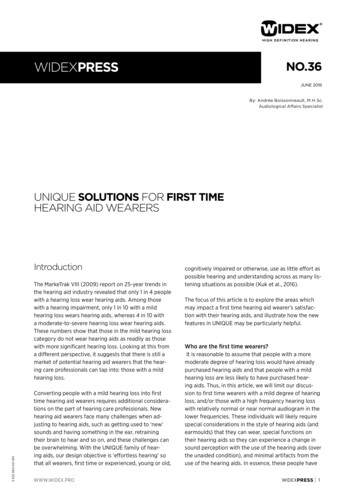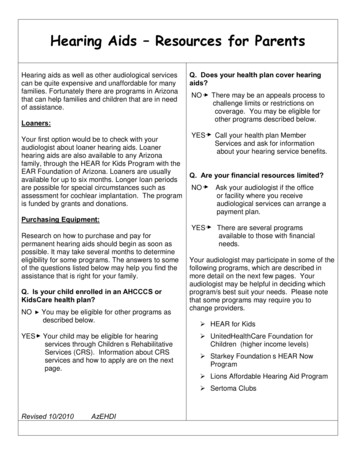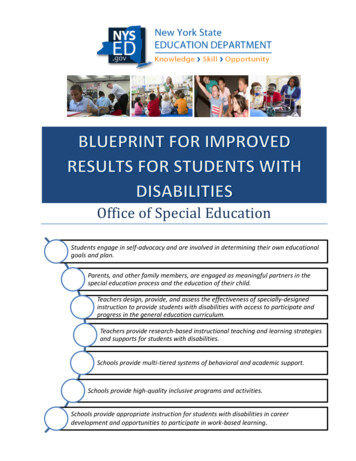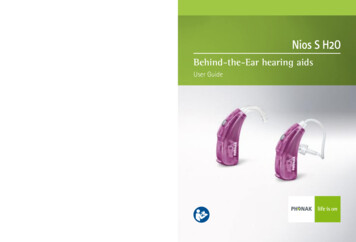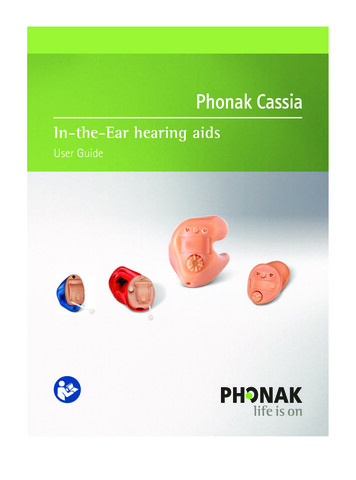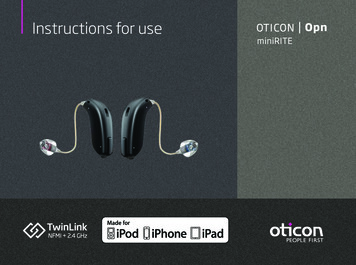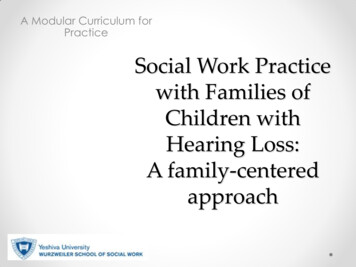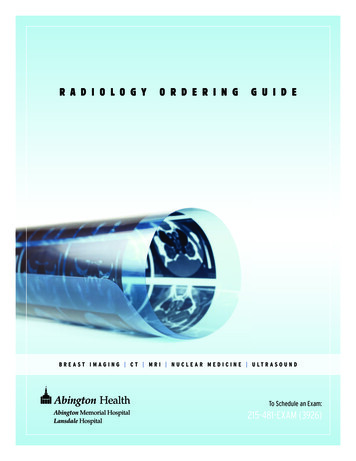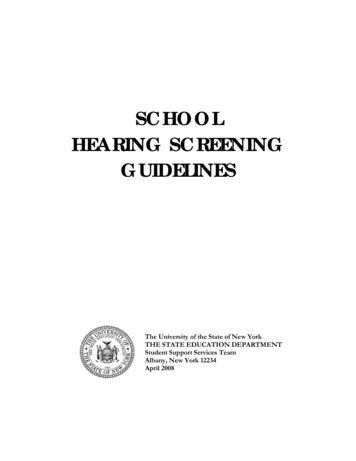
Transcription
SCHOOLHEARING SCREENINGGUIDELINESThe University of the State of New YorkTHE STATE EDUCATION DEPARTMENTStudent Support Services TeamAlbany, New York 12234April 2008
THE UNIVERSITY OF THE STATE OF NEW YORKRegents of The UniversityROBERT M. BENNETT, Chancellor, B.A., M.S. .MERRYL H. TISCH, Vice Chancellor, B.A., M.A., Ed.D. .SAUL B. COHEN, B.A., M.A., Ph.D. .JAMES C. DAWSON, A.A., B.A., M.S., Ph.D. .ANTHONY S. BOTTAR, B.A., J.D. .GERALDINE D. CHAPEY, B.A., M.A., Ed.D. .ARNOLD B. GARDNER, B.A., LL.B. .HARRY PHILLIPS, 3rd, B.A., M.S.F.S. .JOSEPH E. BOWMAN, JR., B.A., M.L.S., M.A., M.Ed., Ed.D.JAMES R. TALLON, JR., B.A., M.A. .MILTON L. COFIELD, B.S., M.B.A., Ph.D. .ROGER B. TILLES, B.A., J.D.KAREN BROOKS HOPKINS, B.A., M.F.A.CHARLES R. BENDIT, B.A. .BETTY A. ROSA, B.A., M.S. in Ed., M.S. in Ed., M.Ed., Ed.D LESTER W. YOUNG, JR., B.S., M.S., Ed. D TonawandaNew YorkNew RochellePeruSyracuseBelle at NeckBrooklynManhattanBronxOakland GardensPresident of The University and Commissioner of EducationRICHARD P. MILLSSenior Deputy Commissioner of Education – P - 16JOHANNA DUNCAN-POITIERAssociate Commissioner, Office of Instructional Support and DevelopmentJEAN C. STEVENSAssociate Commissioner for the ProfessionsFRANK MUÑOZExecutive Director, School Improvement and Community Services (Regional)JAMES C. VIOLABureau Chief, Student Support ServicesROBERT A. JAFFARIANThe State Education Department does not discriminate on the basis of age, color, religion, creed, disability, maritalstatus, veteran status, national origin, race, gender, genetic predisposition or carrier status, or sexual orientation in itseducational programs, services and activities. Portions of this publication can be made available in a variety offormats, including braille, large print or audio tape, upon request. Inquiries concerning this policy ofnondiscrimination should be directed to the Department’s Office for Diversity, Ethics, and Access, Room 530,Education Building, Albany, NY 12234. Requests for additional copies of this publication may be made bycontacting the Publications Sales Desk, Room 309, Education Building, Albany, NY 12234.Updated August 2014
FOREWORDSchool Hearing Screening Guidelines provide local educational agencies with a framework for establishingthe hearing screening program required under New York State Education Law section 905(amended in 2004) and the regulations promulgated there under, specifically 8 NYCRR Part 136(amended in 2005). It explains the purpose of hearing screening in schools and provides guidelinesfor developing effective hearing screening including planning, implementation, and follow-upprocedures. This document is intended for use by administrators and school health personnel.Every attempt has been made to ensure that the information and resources contained in thisdocument reflect best practice in the field of school nursing. Local educational agencies shouldreview these guidelines with their counsel, as necessary to incorporate the guidance with districtpolicy. This document is not intended as a mandate and is to be used for guidance purposes only.ACKNOWLEDGEMENTSThese guidelines were revised with the assistance of an advisory group consisting of the followingindividuals:Susan Brannen, MSChairperson, Audiology DepartmentMonroe 2 Orleans BOCESFlora McEntee, RN, MSSchool Health CoordinatorMonroe 1 BOCESMary Capparelli, RN, CSNPSchool Health ConsultantProject CoordinatorWalter Ramos, RN, Esq.Acting SecretaryBoard for MedicineOffice of ProfessionsNYS Education DepartmentLawrence P. De MersExecutive DirectorBoard for Speech-Language Pathology andAudiologyOffice of ProfessionsNYS Education DepartmentSally Schoessler, RN, SNT, MSEdExecutive DirectorStatewide School Health ServicesCindy Devore, MDNew York State Medical SocietyCommittee on School Health and Sports MedicineLinda Seaman, MSEdAssociateStudent Support ServicesNYS Education DepartmentLinda Haubner, RN, BSN, CFNPPlattsburgh City School DistrictGail Wold, RN, BSNCoordinatorStatewide School Health ServicesCharlotte Kramer, RN, BSN, MSEdBinghamton City School DistrictChristopher A. Kus, MD, MPHPediatric DirectorDivision of Family HealthNYS Department of HealthUpdated August 2014Barbara Zittel, RN, PhDExecutive SecretaryBoard for NursingOffice of ProfessionsNYS Education Department
TABLE OF CONTENTSI.Purpose of School Hearing Screening Program . 1II.Legislative Background . 1III.Establishing Priorities . 2IV.Indicators of Suspicion . 3V.Degree of Hearing Loss . 3VI.Screening ProcedureA.Overview . 4B.Basic Infection Control Procedures to be Followed . 4C.Pure Tone Air Conduction Screening . 5D.Pure Tone Thresholds Screening . 6E.Acoustic Immittance Screening (if available). 7VII.Follow-Through . 8VIII.Religious Exemptions . 9IX.Links/Resources/References . 10APPENDICESA.B.C.D.Sample Procedure: Pure Tone Air Conduction Screening (Sweep Test) . 11Sample Procedure: Pure Tone Threshold Screening . 12Sample Form: Notice Regarding School Hearing Test . 13Audiometric and Medical Findings . 14Updated August 2014
I. PURPOSE OF SCHOOL HEARING SCREENING PROGRAMThe purpose of hearing screening is to identify students with possible hearing losses whichmay affect their intellectual, emotional, social, speech, and/or language development. The key tosuccessful remediation is early identification and intervention, which may prevent educationalproblems and permanent hearing losses. Even mild hearing losses may be educationally andmedically significant.Hearing screening programs should be an integral part of the total school health program. Themajor objectives of a school hearing-screening program are to: Promote an optimal level of hearing for all students. Prevent the development of hearing problems that may affect the student’s healthand potential for learning. Identify students with potential hearing problems. Notify parent or guardian of a child’s hearing screening failure and the need forfurther examination by a physician or audiologist. Establish follow-up procedures to ensure that each identified student will receiveappropriate care. Inform teachers of students with hearing problems and provide recommendationsfrom hearing specialists regarding the classroom environment. Provide appropriate educational accommodations for students with hearing impairment.II. LEGISLATIVE BACKGROUNDChapter 53 of the Laws of 1980 requires school districts to establish a mandatory screening programfor the presence of conditions which are likely to impede a child’s learning. The regulationspromulgated under New York State Education Law section 905 require that hearing screening beprovided to all students within six months of admission to the school and in grades Pre-K orKindergarten, and grades 1, 3, 5, 7 and 10 and at any other time deemed necessary. The purpose ofthe requirement is to detect the presence of hearing problems likely to impede a student’s learning.Students thought to be disabled due to a hearing impairment may be referred for an initial evaluationto determine if the student is a student with a disability, as that term is defined in New York StateEducation Law (Article 89, Sections 4401, 4401-A and 4402).Updated August 20141
III. ESTABLISHING PRIORITIESHearing screening must be administered to all students within six months of admission to theschool and in Pre-K or Kindergarten, and grades 1, 3, 5, 7 and 10.A. Hearing Screening NeedsHearing screening may be done at any time deemed necessary by professional registerednurse (school nurse). Such occasions might involve:1. Students suspected by teachers, parents, physicians, etc., of having hearing loss (whichmay include students in special education programs).2. Students at risk for hearing loss, such as:a. Students with medical conditions, which may affect hearing, including abnormalities of theears, nose, or throat; malformed or low-set pinnae, cleft lip or palate (including submucouscleft), recurrent otitis media, or recurrent serious otitis media.b. Students taking medications known to be oto-toxic.c. Students having a known familial history of hearing loss.d. Students with genetic abnormalities known to affect hearing.e. Students attending public school career and technical education programs where theymight be subjected to damaging noise levels, such as in engine repair shop, printing,carpentry, etc.f. Students exposed on a regular basis to excessive noise levels such as powerequipment, motorcycles, snowmobiles, guns, band participation, and other noisepollutants.g. Students who regularly participate in swimming and/or diving teams, or who use aqualung or scuba gear.h. Students who experience unconsciousness or head trauma (this could be during asporting event or any other cause).B. Hearing Screening – Need to be determinedSome students may not need screening as they are already under care for regular,periodic evaluation for their hearing impairment. Students falling into this category wouldinclude:1. Students with known hearing loss, including sensorineural hearing loss and progressive hearingloss.2. Any student coded Deaf or Hard of Hearing by the Committee on Special Education.3. Any student enrolled in regular or special education who is unable to respond, for any reason,to screening procedures. The school nursing personnel should follow these students to ensurethat they are receiving periodic evaluations and/or care as determined by their hearing carespecialist. Documentation of these evaluations should become part of the cumulative healthrecord (CHR).Updated August 20142
INDICATORS OF SUSPICIONSigns and SymptomsKnowing the signs and symptoms of hearing loss is important when identifying students with asuspected hearing problem.In accordance with the Commissioner’s Regulation (8 NYCRR §136.3 [a] [4]), it is a general duty ofthe trustees and boards of education to maintain a program of education relating to the health ofstudents. This program of education may include information regarding the signs and symptoms ofhearing loss. Indicators include: Recurring otitis media or upper respiratory infections Mouth breathing Draining ears Earache complaints Sudden school failure following a severe illness Frequent requests to repeat what has just been said Irrelevant or inappropriate answers to questions Turning one ear toward speaker Talking either too loudly or too softly Indistinct speech (slurring or omission of sounds) Watching the lips of the speaker Inattention to classroom discussion Making mistakes in following directions and taking dictation Tending to isolate self, being passive, or tiring easily Head traumaV. DEGREE OF HEARING LOSSThe following classifications are based on hearing levels through the frequency range most crucialfor the understanding of speech. Suggestions to address various levels of hearing loss are providedbelow. In addition, consideration should always be given as to whether a referral should be madefor an initial evaluation to determine if the student is a student with a disability.A. Mild hearing loss (21-40 dB)Student has difficulty hearing faint or distant speech.1. Needs favorable seating.2. May benefit from lip reading instruction.3. May benefit from hearing aid or educational amplification, e.g., FM Assistive Listening Device.Updated August 20143
B. Moderate hearing loss (41-59 dB)Conversational speech is just audible at a distance of three to five feet.1. Use of hearing aid, auditory training, lip reading, favorable seating educationalamplification, e.g., FM auditory training.2. Language therapy to aid the student in communication skills.C. Severe hearing loss (60-85 dB)Student may hear voice from one foot from ear.Use of hearing aid, cochlear implant and/ or educational amplification in conjunction withlanguage therapy to aid the student with communication skills.D. Profound hearing loss (85 dB or more)Student may hear only very loud sounds (jet plane overhead, subway, etc.).The student does not rely on hearing as the primary channel for communications, thereforeuse of amplification hearing aids, cochlear implant, educational amplifications, signlanguage interpreter, translator and/or note taker may be appropriate and necessary.VI. SCREENING PROCEDUREA. OverviewThe primary goal of air conduction threshold audiometry is to identify students who might presentwith hearing loss which could potentially interfere with communication and learning and assist inmaking the appropriate referral. As a minimum, schools should perform air conductionthreshold screening for those students failing the 20dB pure tone screen. The goal of theprogram using acoustic immittance measurements is to identify children who have middle eardisorders. The school screening program which incorporates air conduction screening protocolsas well as acoustic immittance screening protocols will be effective in identifying students at risk forhearing loss and or hearing health problems and may need both audiological and otological/medicalservices. It is highly recommended that acoustic immittance measurements be taken for students atthe elementary level whenever possible.B. Basic Infection Control Procedures To Be Followed1. Use a disinfectant wipe on head phones and band prior to use (disposable covers areavailable).2. Disinfect any reusable immittance probe tips or otoscopic speculums or use disposable ones.3. Wash hands thoroughly if ear drainage is visible or suspected.Updated August 20144
C. Pure Tone Air Conduction Screening1. Acoustic environmentThe acoustic environment of the area where the screening occurs is an important variable.Typically school environments are too noisy for screening frequencies below 1000 Hz butare sufficiently quiet to screen frequencies at and above 1000 Hz. Careful snug placementof the earphone increases attenuation of ambient noise and allows for the most accuratescreening protocol. Use of the large circumaural earphones (e.g., Aural domes andOtocups) is not recommended. (These devices do not serve to attenuate noise below 1000Hz and the recommended earphones can attenuate the weaker ambient noise above 1000Hz.) The larger headphones are awkward for smaller children, are more difficult to get asnug and accurate placement and increase the test- retest variability in the screeningfrequencies.Headphones do not eliminate the need for a quiet screening environment or a sound isolatedaudiometric test booth. In extremely noisy environments, the audiometric test booth is oftenthe only means of providing an environment quiet enough for audiometric screening.2. Screening proceduresa. Individual as opposed to group screening is recommended.b. Manual as opposed to automatic procedures is recommended.c. Only pure tone signals should be used.d. Standard TDH 39/41 headphones are recommended.e. Test frequencies should be 1000, 2000, 4000Hz.f. Screening levels should be 20 dB (re: ANSI 1969/ANSI 1971) at all frequencies tested.g. At the beginning of each day that screening audiometry is performed, theaudiometer should be turned on prior to the screening session. At 20 dB listenthrough both the right and left earphone to be sure that both are working. Leavethe audiometer on throughout the day.h. Seat the student so that they cannot see you operate the audiometer. (Especiallyfor younger children or children with disabilities, it is best if you can see the child.)i. Give clear concise instructions. For example: “I will place these headphones overyour ears. You will hear beeps, which will be very soft. Listen carefully. Raise yourhand each time you hear the beep (noise).” (Do not instruct which hand to raise.)j. Ask the student to remove eyeglasses, large earrings or other accessories thatmight interfere with the headphone placement. Push hair away from ears.Red Earphone- over student’s right earBlue Earphone- over student’s left earBe sure that the speaker portion of the earphone is lined up opposite the opening of theear canal.k. To be sure that the student understands the instructions, start the screening protocol at40 dB at 1000 Hz. (If the student indicates that they hear better in one ear over theother, start with the indicated ear. Otherwise, start with the right ear.) Once it isestablished that the student knows to raise their hand when a tone is presented, startthe screening protocol.l. Set audiometer to 20 dB. Test at 1000, 2000 and 4000 Hz. Elicit 2 positive responsesat each frequency. Change to the other ear and repeat.Updated August 20145
3. Failure Criteriaa. Failure to respond to any recommended frequency in either ear at 30 dB shall constitutefailure of the air conduction screening. The student should be rescreened during the samesession or within one week. Failure criteria remain the same. If the student fails a secondscreen, then air conduction threshold screening should be completed.b. Inability to comply with screening protocolStudents with disabilities are sometimes unable to follow the recommended screeningprotocol or are reluctant to have the headphones placed. These children should follow analternate protocol conducted in an audiometric booth by an audiologist.4. Recording Screening ResultsRecord screening results and date of screening on Cumulative Health Record (CHR).(See Appendix A for sample procedure - Pure Tone Air Conduction Screening [Sweep Test])D. Pure Tone Threshold Screening1. Acoustic environment (same as 20 dB sweep screen- quiet).2. Screening ProceduresStudents who have failed the 30 dB pure tone screen should have the air conduction thresholdscreen on the same day or within one week of the failed 30 dB screen.a. Prepare students, review directions. Test frequencies shall be 500, 1000, 2000, 4000,6000 Hz.b. Begin testing at 1000 Hz, 40 dB. Maintain each tone presented for no longer than 1 or 2seconds. Manual method is recommended.c. If there is a response at 40 dB, drop back in 10 dB increments until there is no longer aresponse, then increase in 5 dB increments until a response is elicited. Drop back again in10 dB increments and increase in 5 dB increments to confirm the threshold. (Example:40dB response, 30 dB response, 20 dB no response, 25 dB response, 15 dB no response,20 dB no response, 25 dB response- record as threshold.)d. If there is no initial response at 40 dB, increase in 10 dB increments until a response iselicited. Then drop again in 10dB increments until a no response is given, increase in 5 dBincrements until a response is elicited, drop 10 dB until a no response and increase 5 dB,until thresholds is again crossed. (Example 40 dB no response, 50 dB, no response, 60 dBresponse, drop to 50 dB response, drop to 40 dB no response, increase to 45 dB noresponse, increase to 50 dB response, this is the threshold having received a response 2times.) There is no need to establish a threshold above 60 dB.e. Test remaining frequencies (500, 2000, 4000, 6000 Hz) in same manner.f. Record the softest dB level heard for each frequency on a graph form or some type ofdata sheet. Retain a copy for CHR.g. If consistent responses cannot be obtained for a given frequency, obtain thresholds andcomplete the audiogram for the other frequencies, then return to the frequency presentingdifficulty. If thresholds are reduced for the first ear (and not for the second ear) return tothis first ear and repeat procedure. When administering this test avoid presenting thetones in rhythmic sequences and take into consideration the reaction time of the childbeing tested.Updated August 20146
3. Failure Criteriaa. Threshold level of 30 dB or more for two or more tones in one ear; orb. Threshold level of 35 dB or more for one tone in either ear.Note: If available, perform acoustic immittance screen for students. Otologicalassessment may be of value.4. RescreeningFailure of the pure tone threshold screen and/or acoustic screen necessitates rescreening,preferably in the same session in which the failure occurred. Removing and repositioning theheadphones and or probe tip, accompanied by careful reinstruction markedly reduces the numberof false failures. The rescreening, using the same procedure and failure criteria is an essentialprocess for improving the efficiency of the screening program. The maximum time delay forrescreening should be no greater than one week. Failure on rescreening of pure tone thresholdscreen and or acoustic immittance screen according to criteria outlined constitutes failureof the school screening procedure.5. Recording Screening ResultsRecord screening results and date of screening on CHR.(See Appendix B for sample procedure - Pure Tone Threshold ScreeningE. Acoustic Immittance Screening (if available)1. Acoustic environmentA controlled acoustic environment is not necessary for the screening of middle ear function.2. Acoustic Immittance screening proceduresa. The recommended air-pressure range used should cover a minimum of 100 to –300 mmH2O. The greater range in the negative direction is recommended because abnormalities inchildren are usually revealed in this dimension.b. An automatic constant-rate pump system with a recording system is recommended. Theinstrumentation may include an automatic recording system in order to reduce screeningtime, decrease the possibility of recording time, and decrease the possibility of recording errorby non-professionals, and produce a permanent record of test results.c. Follow manufacturer’s instruction for operating machine.d. Assure equipment is working. Do the following each day of use:1. Calibrate using cavity provided by manufacturer2. Check it on yourselfe. Take health history relating to ear.f. Do visual check to determine the size, shape and direction of ear canal. If possible,conduct otoscopic assessment of ear.g. Give clear concise directions:“Please sit quietly. You will feel a soft tip in the outside of your ear. You will hear abeep/noise and feel some pressure. Some of the beeps are loud. Remain seated quietly.Please do not raise your hand or talk.”Do not continue with screen if:1. Pressure equalization tube is visible.2. Ear is draining.3. Ear is totally occluded with waxh. Select appropriate probe tip size. Place probe tip to ear canal. Test each ear.Updated August 20147
3. Failure criteriaa. A tympanogram (type B) that indicates no pressure peak or movement of the drum. (Aflat line or slightly domed shape will be drawn on the graph.)b. Inability to comply with test procedure.c. Inability to perform immittance screen because of draining ear(s), ear(s) occluded withwax, presence of pressure equalization tube(s).4. Rescreeninga. Failure of the acoustic immittance screen necessitates rescreening, preferably in the samesession in which the failure occurred. Removing and repositioning the probe tip,accompanied by careful reinstruction, markedly reduces the number of false failures.Rescreening using the same procedure and failure criteria is an essential process forimproving the efficiency of a screening program. The maximum time delay forrescreening should be no greater than one week.b. If upon rescreening, the student passes both threshold screen and acoustic immittancescreen, the student passes the screen.c. Failure on the rescreening of air conduction thresholds and/or acoustic screen accordingto the criteria outline constitutes failure of the school screening procedure. Failures onthe rescreening should be referred for further medical evaluation. Some students,especially young children, will fail both the screening and rescreening procedures andthen yield normal thresholds on an audiological evaluation. Therefore a hearing loss orimpairment should not be considered identified until verified by further evaluation.5. Recording screening resultsRecord screening results and date of screening on CHR.FOLLOW-THROUGHA. Parent /Guardian NotificationWhen a student has failed hearing screening, necessitating a medical referral, the parent/guardianshould be notified by conference or telephone communication and/or written form, i.e.Notice Regarding Hearing Screening (Appendix C) (and to the extent practicable in a language that theparent/guardian can understand).The parent/guardian should be advised of the results of the screening, and that the child should beseen by their primary care provider and may need to be seen by a licensed audiologist and/orotolaryngologist. If this latter evaluation is necessary, it may be done at no charge to the familythrough the regional State Health Department approved hearing and speech centers. (Manyschool districts or Boards of Cooperative Educational Services provide audiological,medical/otological evaluations at no cost to the parent/guardian.)Updated August 20148
B. Teacher/Staff NotificationResults of the hearing screening should be filed in the student’s cumulative health record. Necessaryinstructional staff should be notified that the student has failed hearing screening and therefore maybe experiencing difficulty hearing and responding to oral instruction. Until the student’s hearingstatus is clearly defined by medical and/or audiological evaluation, the following measures shouldoccur:1. The student should be given preferential seating so that he/she is in direct line of theteacher’s/speaker’s voice. Optimum distance is four to six feet from the teacher. If a better earhas been identified the student’s better ear should be toward the teacher.2. Teachers should use appropriate clarification strategies to assure that the studentunderstands oral information (repeat, rephrase, have student repeat, etc.).3. Whenever possible, teachers should avoid:a. Standing in front of a bright window while speaking.b. Speaking while writing on the chalkboard.c. Positioning themselves so that their faces are not visible to students.4. Noisy learning environments should be avoided or minimized.C. Continuing Evaluation in the School SettingUntil medical diagnosis and evaluation has been completed, the student failing hearing screeningshould be rescreened monthly. This screening will provide for documentation of a fluctuatingand/or permanent condition. Appropriate follow-up with parent/guardian and providers shouldoccur to obtain needed diagnostic and treatment information. Supplemental records, i.e.,audiologist’s report and otological/medical reports, should be retained in the student’s cumulativehealth record.VIII. RELIGIOUS EXEMPTIONSHearing screening will not be required where a student, the parent, or person in parental relation tothe student, objects to the screening on the grounds that the screening conflicts with their genuineand sincere religious beliefs. A written and signed statement from the student, parent or person inparental relation to the student that they hold such beliefs must be submitted to the principal or theprincipal’s designee in which case the principal or principal’s designee may require supportingdocuments.Updated August 20149
IX. LINKS/RESOURCES/REFERENCESResourcesNew York State Education Department, Amendment to NY State Education Law, Article 19, Medicaland Health Services. Section 905. (Effective September 1, 2005). Retrieved August 22, oolhealthservices/Article19Revisions.htmlNew York State Education Department, Education, P-16: Regulations of The Commissioner ofEducation, Sections 136.1, 136.2 a
Hearing screening programs should be an integral part of the total school health program. The major objectives of a school hearing-screening program are to: Promote an optimal level of hearing for all students. Prevent the development of hearing problems that may affect the student's health and potential for learning.
